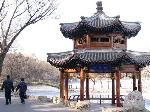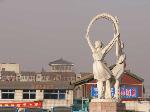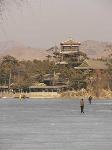- Getting around Lijiang. Dont stay in the Old Towns more than 2 days, there is nothing to do. KRISS Oct 9, 2013 05:46
- 2013 Beijing Temple Fair BENNYLAU Feb 26, 2013 03:29
- Malaysian traveling from KUL - LAX vis Shanghai PVG ZATI_DY Jan 3, 2013 20:15
An Emperors' Playground - Part One
- Views: 4205
- |Vote: 0 0
- |Add to Favorites
- |Recommend to Friends
A Happy Accident
It’s a story that could have been a scene from a fairytale – a great Emperor swathed in stylish robes, out hunting on his royal horse, makes a wrong turn and discovers a wonderland of pristine and exceptional beauty, and from that moment on the fate of this remote paradise is changed forever. Then known as Rehe, it became the site of the Qing Dynasty’s most fabulous summer palace and its most elaborate project of intercultural diplomacy. Sometime later, after a series of mysterious deaths, all those fabulous and ornate palace buildings and temples were abandoned and became oddly picturesque features of the agricultural landscape, pretty ruins of wood and tile overgrown in grass and bush, temple courtyards worked over for planting.
Many winters later, the dynasty fell and all the former imperial properties became public concerns, and the old summer palace at Chengde saw its renaissance as a unique tourist destination – one that for its historical significance and superb design has seen it achieve UNESCO protection status as a place of world heritage. What was once the whim of an Emperor has become something that the whole world can claim as one of the recognised greatest achievements of our race, something that’s in the interests of all our children to honour and protect.
Some three hundred years after the Emperor Kangxi had stumbled his way into the area and sealed its destiny, I followed in his footsteps – albeit on an overpriced and far from comfortable peak-season minibus – and arrived at the grubby city of Chengde that takes its earnings from the restored palaces and temples at its northern edge. Had I arrived in the summer, the place would have been overcome with foreign faces and domestic travellers all swooping down on the tourist areas – but instead I’d chosen to visit in the relatively uncrowded winter time when the town was dead and my European face a notably unwelcome surprise to everyone I passed. It was almost Spring Festival – which accounted for my pricey bus ticket – and exceptionally cold. I also had great difficulty finding a mid-range hotel that would put me up for the weekend – and so by the time I had checked in I had already become unimpressed with the city. It seemed unusual that such a first-class destination could be so overtly unentrepreneurial – thousands of tourists arrive in Chengde every year, and I’d expected the city would be well-developed and eager to cash in on the cash inflow from visitors. Instead, I had the impression that I was something of an imposition on local Spring Festival celebrations, and a nuisance at a time when the hospitality industry staff were preparing to rest.
In fact, Chengde itself is actually a very modest town, one that proceeds very humbly into its future as the tourist industry tumbles along loudly at its fringe. The area around the train station where I was let off is the least attractive part of the city, and so after settling in I was eager to cross the Wulie River and get into the city’s more developed area to get familiar with the new Chengde before I made my explorations into the old.
The City of Chengde
I walked the long, straight road to the river – although it was in the middle of the cold season, the streets even this far out of the city centre were busy with streetside stalls and the lights from the toys and trinkets on sale from blankets spread out over the footpath. Racks of coats and trousers, stuffed tightly onto rows of hangers, appeared to be drab but cheap – I purchased a pair of cosy plastic-wrapped gloves for five yuan, and hurriedly unwrapped them as my fingers were already stiff in the icy wind. The carriages of a train hurtled past on the railway bridge as I crossed the river on the pedestrian side, its passengers glibly staring ahead, oblivious to the fact that the clack of the wheels were carrying them past ancient glories.
Central Chengde is based around Nanyingzi Dajie, a broad street of fashionable stores parallel to the river and certainly where the action is as far as this otherwise unremarkable city is concerned. Most of the locals that were outside seemed to be here, and so I headed in this direction in search of a meal – which in Chengde invariably means dumplings. Every second restaurant is a dumpling store, and afer briefly considering looking for something else I caved and ordered a few baskets to assauge the as-yet unanswered hunger of my long bus-ride.
The restaurant was also a good place to stop a while and check out the colourful map I’d just purchased which gave the layout of the city and its enormous reserve and numerous temples. A superb rendering of the city as it once was in history was contrasted with the reality of the present day. The palace itself is enclosed within a vast walled quarter that contains not only the buildings where the Emperors lodged and ruled, but also a great number of other Imperial leisure and study facilities, as well as ample area for hunting, the pastime that had led to the discovery of the park in the first place. Outside the walls, a reported number of 12 temples catered for all religious tastes and variations within the empire, great ostentatious installations many of which were absolutely enormous, and one of which was a good approximation of the Potala Palace in Lhasa. No matter who was visiting the Emperor in his vacation resort, they would find a place to worship, a move which successive Emperors judged would greatly facilitate their diplomatic advantage.
On the map, however, I counted at least 15 temples, and furthermore it was enticingly unclear how many of them were historical, how many were extant but in ruins, and how many were restored and selling entrance tickets. Not only that, but there were plenty of temples within the enclosed park itself, and so it was to the resort where I headed first for an overview of where the Emperors lived and played during hot Summers away from the capital.
The Mountain Resort
Busses connect Nanyingzi Dajie with the Mountain Resort with frequent services. Before too long and after rather too many dumplings, I was at the gate, and 90 yuan later I was within the resort.
Visitors to the Mountain Resort very quickly discover that a comprehensive survey of the grounds is impossible in a short visit, and that to get the most out of the park it’s advisable to spend at least a couple of days exploring. There’s something for everyone – splendid architecture that has stylistic roots all over China; grand towers and halls and libraries; ornate temples and wide, open grounds. Perhaps most appealing, especially after long sessions concentrating on ancient cultural glories, is the lake area – which when I visited in the middle of a north Chinese winter was frozen over and teeming with brightly-clothed skaters. The ice crust was a deep aqua-marine, and I walked out to the middle of the lake to look at the palace buildings around it – particularly enjoying the magnificent view of the grand Shang Di Ge, which bears striking resemblance to the Yiheyuan Summer Palace in Beijing. From the top of the frozen water I could see deer playing at the lake edge – Kangxi and his descendents used to keep them in the palace for their hunting purposes, but nowadays the resident venison have safer occupations as living exhibits.
The main palace is an unimposing complex with stylistic similarities to the Forbidden City, but without the strict geomantic symmetry that is observed in the latter. The various halls for business and pleasure may lie in informal patterns, but they are all stylishly adorned and finished with the deep, rich shades of Nanmu wood panelling and pillar supports – a strong and beautiful wood favoured by the Emperors. Walking the long covered corridor-walkways between buildings, especially in the less crowded winter, it was easy to follow the strolling Emperors in the mind’s eye and follow their gaze and they looked over the natural grounds with satisfaction.
For almost a couple of centuries the Emperors came here and enjoyed the air and the beauty, and entertained visitors from near and far. England’s first delegation to the rulers of the mighty eastern empire, led by Lord McCartney, failed spectacularly here – McCartney had arrived at Beijing to find the Emperor was on holiday, and came all the way to Chengde to have his entreaties for trade ignored and be sent away, regarded as an ignoble barbarian for not according the Emperor with the proper respect. But just as the Chengde resort was starting to look as if it could rival the palace in Beijing, things took a turn for the worse. Two Emperors died here in succession – creating the impression that the whole complex was cursed – and just like that, it was abandoned.
Although much of what was once to be found here has since gone the way of all things, the restorations of the present age have brought something invaluable back from the past, and to be able to enjoy it in these times is something to be most grateful for. I had much left of the complex and outlying temples to explore, and I eagerly anticipated taking the next couple of days to look around in more detail.






 Copyright © 1998-2025 All rights reserved.
Copyright © 1998-2025 All rights reserved.